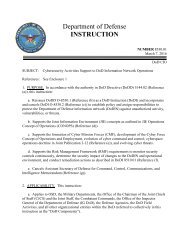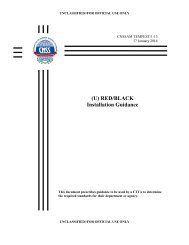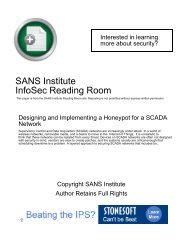BCOP-IPv6_Subnetting
BCOP-IPv6_Subnetting
BCOP-IPv6_Subnetting
Create successful ePaper yourself
Turn your PDF publications into a flip-book with our unique Google optimized e-Paper software.
BEST CURRENT OPERATIONAL PRACTICES – <strong>IPv6</strong> <strong>Subnetting</strong> (v1) <br />
single pool within the addressing hierarchy (regardless of the utilization in other pools). However, this policy <br />
is not yet currently supported in the other regions. As such, networks that are likely to require a subsequent <br />
allocation from RIRs other than ARIN may want to consider rounding up only to standard CIDR boundaries <br />
(powers of two). <br />
3. Implement a hierarchical addressing plan to allow for aggregation<br />
In a typical network, this equates to at least three levels of hierarchy; site, region and AS. A site can be a <br />
PoP, a building, a floor, or any other logical layer3 aggregation point within your network. In general, <br />
each site should receive one /48. <br />
Figure 2 -‐ Example 3-‐level Hierarchy <br />
In some cases, a network may need additional aggregation points and thus a deeper hierarchy. In an <br />
extremely large network, this could be, for example; department, floor, building, campus, region, AS. <br />
Another important consideration is that this large address space facilitates grouping types of usage <br />
within your address space (using common bit patterns for common uses). Grouping customer space <br />
(used by external parties), infrastructure space (interface addresses), internal space (used for the <br />
corporate network) critical internal space (RADIUS, TACACS, jump servers), etc., may make sense in your <br />
environment. Having a well-‐defined addressing plan that distinguishes between the various address <br />
usage types can simplify and reduce filter size. <br />
4. One /48 from each region should be reserved for infrastructure<br />
Reserve the first or last /48 from each region for infrastructure needs; interface numbering, loopback <br />
addresses, etc. <br />
a. Loopbacks should be allocated from the first /64<br />
Chris Grundemann <br />
3
















